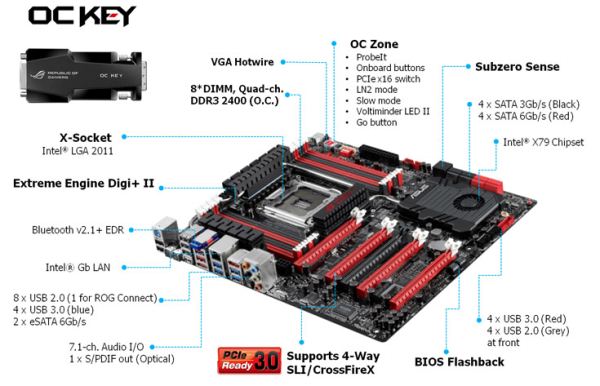ASUS Republic of Gamers and X79 ROG Review – Rampage IV Gene, Formula and Extreme
by Ian Cutress on August 3, 2012 1:00 PM EST- Posted in
- Motherboards
- Asus
- X79
- ROG
Rampage IV Extreme Conclusions
Halo products are big news and big business. If your product is the best, and everyone says it is the best, then those that ask will get your product as the answer. As a result, the person who asked may then go out and purchase one of your products. The downside of a Halo product is that it requires a lot of time and investment - lots of research and development that may not pay off if another company jumps ahead of you. Chances are as well that due to all that investment, the halo product itself will not even break even. However, you are hoping that it will filter down to the regular products and boost their sales.
I should stress that the halo product is different to the 'ultimate' product. The halo product only has to beat the competition to be number one, rather than cater for every single need in every single category. There are many examples of this in the history of motherboards where particular companies have placed on their products a variety of superfluous functionality that means nothing to most people, often at great expense.
With the ROG brand, and particularly with the Rampage IV Extreme, the prize is the Halo effect. In the minds of ASUS, they needed a product that would achieve the pinnacle of performance, whilst still being a great board to manipulate. This is why they hired, inter alia, Andre Yang and Peter 'Shamino' Tan on to the team - two of the world's best overclockers, in order to invest time into improving the range of ROG products.
Performance wise, it is hard to stop the Extreme it its tracks - as with all the other ROG motherboards in this review, the MultiCore Enhancement at stock means that out of the packet, this X79 board is one of the best performing on the market. If we couple that with some other hardware and nice overclocks, we can break records, or with some sub-zero cooling, world records for performance. The features on board to aid this are also numerous: VGA Hotwire useful for GPU overclocking; the enhanced LN2 mode gives the already substantial BIOS a kick in the rear; SubZero Sense removes the need for thermometers; and the added OC Key is a marvelous piece of technology to allow the enthusiast to view and adjust values on the fly.
To be the best, you have to perform the best. If you have enough green in your wallet, then the Rampage IV Extreme will offer you that base of performance from which to launch any world record attempt. While it may not be for everyone (regular users would prefer the Gene or Formula), as an overclocker we can tweak the RIVE to our hearts content.
At $430, double the price of the ASRock X79 Extreme4-M, is the Rampage IV Extreme a good buy? Compared to the 4-M, the RIVE feels like more than double the board, in terms of features and performance. Let us not forget, users of the RIVE may also be spending $999 on a processor, so there would be good reason to pair it with a board more geared to deal with the power and price is probably not an issue.
With all this in mind, I would like to give the Extreme an AnandTech Editors' Choice Silver Award. If your usage scenario is power, and you want an array of tools in order to take down the best scores of a CPU generation, then the Rampage IV Extreme is the best tool to do it with should money be no object.

ASUS Rampage IV Extreme
Silver Award











34 Comments
View All Comments
jontech - Friday, August 3, 2012 - link
But sounds kind of cool,.Helps that Asus makes it :)
Paulman - Friday, August 3, 2012 - link
Asus Republic of Gamers also holds Starcraft tournaments, as well! That's how I first heard of their brand. In fact, the ASUS ROG Starcraft II Summer 2012 tournament is on right now and I'm watching a game vs. EG.IdrA and EG.Puma (same team, but one American teammate versus a Korean teammate).For more info on this tourney, see: http://rog.asus.com/142982012/gaming/join-the-rog-...
primeval - Friday, August 3, 2012 - link
A fun tournament thus far.For the branding portion of this article, I highly recommend checking out some of ASUS ROG's commercials. They have been playing throughout the aforementioned tournament and I have to say they are probably the best hardware commercials I have ever seen in terms of production quality. I think that if you see a few of those commercials, you may be able to further rationalize the branding award.
Meaker10 - Friday, August 3, 2012 - link
1x/16x/8x/16x would kill any dual card setup in a micro atx case, kinda defeating the point....just4U - Friday, August 3, 2012 - link
the 8x slot is rather pointless...danjw - Friday, August 3, 2012 - link
I would rather see an article on the Ivybridge ROG motherboards then the Sandybridge-E ones. These are very niche boards, though I guess that is only slightly less true of the Ivybridge boards. For heavily threaded and memory intensive applications Sandybridge-E will win. But not really on much else, though they are chosen by some just because they are the most expensive.StevoLincolnite - Friday, August 3, 2012 - link
Also, Sandy Bridge overclocks higher and throws out less heat, because of the silly design choice that Intel made in regards to the heat spreader compound.Not a problem for those who are up to the task of removing the IHS or lapping.
Sad part is that Ivy Bridge actually has nice thermals and power consumption at stock; which could have translated well for enthusiasts.
IvyBridge-E should be out within the next year, haswell will get released and the cycle shall continue.
Hopefully we get 8 core Ivybridge-E chips, which is severely lacking on the Socket 2011 platform with the 3930K's being die harvested 8 core chips, plus most socket 2011 motherboards will take an Ivybridge-e chip anyway, when they're released.
danjw - Friday, August 3, 2012 - link
I was just looking at "leaked" slide that shows Ivy Bridge-E out in Q3 2013 and Haswell out in Q2 2013. I really don't see what the point is of an Ivy Bridge-E if Haswell beats it to the market. With Sandy Bridge-E they released it before the Ivy Bridge tock. I just don't see why that would make much sense.Assimilator87 - Saturday, August 4, 2012 - link
Haswell will probably be limited to four cores, whereas Ivy Bridge-E will scale up to ten cores.mapesdhs - Wednesday, May 9, 2018 - link
I was hunting for R4E refs and found this. It's strange reading what people expected was going to happen back when the R4E was new. IB-E with 10 cores eh? Oh well. Mind you, that did happen with IB-EP, and infact the XEON E5-2680 v2 is one of the best upgrades one can do for an X79 mbd, at least for threaded performance anyway. Hard to avoid wondering how things would have panned out if the 3930K had simply been a fully functional 8-core in the first place, instead of the crippled sampled chip consumers were offered. However, I obtained quite a few, and they still work pretty well, especially with so many PCIe lanes to play with, and it's cool being able to use a 950 Pro to boot from NVMe (comes with its own boot ROM), though the ROG forum does have a thread with custom BIOS profiles available to add native NVMe boot support to various ASUS mbds.